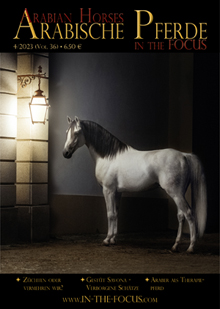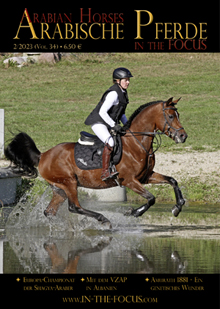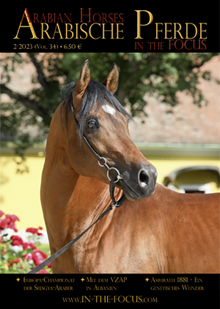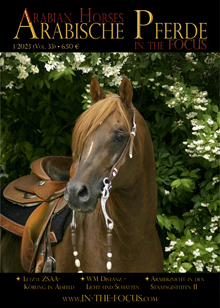Unto the pure all things are pure, according to the Bible, but not so much unto breeders of purebred Arabians. On the contrary, their (perfectly understandable) attempts to follow in the footsteps of the Bedouins and preserve only the purest desert bloodlines have yielded some strange and contrary results.
Things were easier in the past. Purebred Arabians were purebred Arabians, and in the rare cases where some actual non-Arabian blood was discovered in pedigrees, those horses were simply removed from the stud books, and that was that.
This changed during the 1960s, when the first attempt was made to catalogue the truly “asil” Arabians – those whose pedigrees could be traced back to the Desert in all lines, according to the original breed definition – with the idea of breeding them to each other, thus preserving their authenticity. It was caused by the discovery that the pedigrees of Polish Arabians contained many “blank spots”, ancestors that appeared to originate not in the Desert, but in Poland. Eliminating all such horses would have been impossible, as they included the stallion Skowronek, whose descendants spread out from Crabbet Park all over the world. Skowronek in particular has been the subject of numerous articles arguing for or against his purebred status. But that is not the subject of this article, which is more concerned with the big picture.
How To Define Purity?
The pioneering work in this field was done by Jane Llewellyn Ott in the USA. In the early 1950s, with the help of Carl Raswan, she began to examine the pedigrees of all purebred Arabians registered in the USA and to catalogue those who passed the test. The covers of the notebooks she used happened to blue. In 1961, she published the results of her work as the “Blue Catalog“, which was followed by several supplements. This “Blue Catalog” became the first bible for breeders of asil Arabians.
There is nothing actually wrong with this, in principle. The attempt to identify and preserve those horses that can be proven to trace exclusively to the Desert is perfectly legitimate and of no interest at all to the breeders of Polish Arabians and Skowronek descendants. But even then, Miss Ott regarded some pure horses as purer than others, following Raswan’s belief that the Muniqi strain might be tainted. So she divided the horses into “Blue List“ (all asil horses, including those with Muniqi blood) and “Blue Star“ (those without Muniqi blood), whom she regarded as the purest of the pure. This logic contains an obvious flaw: the fact that the information we have does not show any Muniqi blood does not necessarily mean there is none, since the data is incomplete. Quite apart from this, Raswan’s prejudice against the Muniqi strain has long since been proved invalid, so the division makes little sense. But of course some people prefer to have something especially exclusive …
Another problem with such catalogues is that they depend on the selection criteria of the person compiling them. For not entirely rational reasons, Miss Ott found herself unable to accept several horses whose authenticity is really beyond doubt. One of these was the Crabbet stallion Nureddin II (Rijm / Narghileh), a tall and somewhat plain horses who was a full brother to the very typey Nasik, whom Miss Ott accepted without question. But in Nureddin II’s case, she suspected foul play, simply because he was so very different (meaning bigger and less typey) from his brother. This is perfectly ridiculous, because he was bred by the Blunts who were themselves fanatic about purity (unlike their daughter Lady Wentworth). The Blunts would never have used Skowronek. To accuse them, of all people, of deliberately introducing non-Arab blood, is quite outrageous.
This is equally true of the much maligned desertbred mare Basilisk, imported by the Blunts. While it is true that there were initial doubts about her background, all open questions were eventually answered to Lady Anne’s satisfaction. If not, she would never have used this mare in her breeding programme. But it seems that Lady Anne’s expertise was not good enough for Miss Ott. Both Nureddin II and Basilisk were not completely excluded from the Blue List, but they and their descendants were relegated to so-called “sub-lists” as horses whose purity, at least in Miss Ott’s opinion, was not entirely proven. Which, of course, instantly labelled them as “impure” in many peoples’ eyes.
Unfortunately this attitude towards Basilisk, who is found in some straight Egyptian pedigrees, still prevails in some circles today. The absurdity of it all becomes evident if we compare this case to that of El Deree, who appears in straight Egyptian pedigrees for more often than Basilisk. When the Blue List was created, no more was known of his background than of Basilisk’s. He was a desertbred with a strain name, no more. Despite this, Jane Ott did not doubt his authenticity, nor did any of the other asil associations that followed after her. How come? Could the reason be that if you doubted El Deree, you would have to evict the majority of straight Egyptian horses from the hallowed halls of purity?
All this shows the problems inherent in such catalogues. In the case of El Deree, it should be added that his authenticity was finally established in more recent years. But when Miss Ott published the Blue Catalogue, it was at least as murky as Basilisk’s, proving that the same criteria were not impartially applied to all horses.
The attempt at establishing a register of asil horses is of course perfectly valid. During the 1970s, several private associations were formed with the same goals: the Asil Club in Germany and Al Khamsa in the USA, as well as the even more specialised Pyramid Society. Their verdicts on individual horses were not always identical with the Blue Catalog’s. The Asil Club did start out with a kind of “sub-list“, applying an asterisk to some horses regarded at doubtful, but this caused quite a bit of opposition and was eventually abandoned. However, the Asil Club has its own selection criteria and is the only such group to accept horses that are not accepted by WAHO. Al Khamsa in America is arguably the most inclusive group and accepts Basilisk as well as other horses that are not accepted by certain groups of breeders. There are a few such horses, though the reasons for not accepting them are equally as spurious as in the case of Basilisk. Yet these horses are often rejected with a vehemence, not to say fanaticism, that makes Miss Ott’s attitude towards Basilisk appear positively benign. This shows the fundamental problem: even the proponents of the asil idea themselves are unable to agree on which horses are asil and which are not.
The Lure of the Exclusive
As a result, there are various sub-groups among the asil breeders that concentrate on a certain, often very limited, gene pools which they try to preserve. In some cases they believe these horses are “purer” than others, but sometimes it is simply the attempt to preserve bloodlines that are endangered. Let us look more closely at these groups.
The Pyramid Society was founded in the USA during the 1970s and has a branch in Europe as well. As the name indicates, its members are breeders of Egyptian Arabians, commonly referred to as „straight Egyptians“. These straight Egyptians are by far the biggest group among the asil horses, which means they are the largest population of horses in the world that trace back exclusively to the Desert. By definition of the Pyramid Society, these horses have to trace in all lines to the Egyptian state stud and the former private studs of the Egyptians kings and princes and the private studs supervised by the EAO, as long as the horses are asil. The Skowronek descendants bred by Hamdan Stables (yes, they exist!) are not considered “straight Egyptian“, despite having been bred in Egypt for many generations.
Although the straight Egyptian gene pool is limited already, there are a number of sub-groups concentrating on even smaller gene pools. This does not include those breeders who – as mentioned above – reject individual bloodlines as “impure”, nor the closed population of Katharinenhof Stud, which represent individual choices. We are looking at groups of breeders getting together with same goal in mind.
First among them are the Babson Egyptians. Straight Babsons also represent a closed population, based on the horses Henry Babson imported to the USA from Egypt in 1932. These were one stallion and five mares from the state stud and from the stud of Prince Mohammed Ali, all of them of “old“ Egyptian bloodlines, i.e. predating the EAO and General Pettkö-Szandtner. They are free of Nazeer blood and the blood of the desertbred stallions later used by the EAO, tracing entirely to the original breeding programs of Abbas Pasha, Ali Pasha Sherif, and the Blunts. These horses are of course highly inbred and often very small, but they are known for their qualities as riding horses, their athletic ability, and their friendly dispositions. They make an excellent outcross for the more mainstream Egyptians, which the Ansata Stud made good use of with horses like Prince Fa Moniet and Falima. Not many Babsons are found in Europe, though there are a few in Germany, the Netherlands, France, and Britain.
There is another, small group of Babson horses, known as Babson-Turfa. They are asil, but not straight Egyptian, since their pedigrees include the mare Turfa db. Turfa was bred by the Saudi royal family and came to England as gift to the British royal family; in 1941, Henry Babson imported her to the USA. Some of these horses came to Germany in the 1970s; their descendants are still bred today by the El Khadir stud.
The so-called Doyle Egyptians are the smallest and most strongly inbred population in the world, being descended from only three horses that were already closely related. They are also the last asil Crabbet horses, since they are descended in all lines from the Blunts’ horses, combining the Egyptian blood from Ali Pasha Sherif with the original Blunt imports. They are only found in the USA. Despite being extremely inbred, some of them have been excellent endurance horses. Some years ago, a Doyle stallion was taken to England on lease and used there for pure Crabbet breeding.
The Sheykh Obeyd group, named after Lady Anne Blunt’s stud farm in Egypt, also attempts to preserve old Egyptian bloodlines, i.e. prior to the modern EAO. This includes both the Babson and the Doyle horses as well as all straight Egyptians that do not carry the blood of the desertbred horses later added to the EAO. This means that while Nazeer qualifies as Sheykh Obeyd, El Deree does not. The number of horses qualifying for this group is naturally quite small.
While all straight Egyptians are asil, not all asil horses are straight Egyptian. In Germany, for example, there is the small group of asil Weil horses. While their pedigrees are predominantly Egyptian today, they also trace to the Syrian foundation horses imported by King Wilhelm I of Württemberg. This group does not have a lobby, its numbers are very small, and it is only preserved at Marbach State Stud. Its most famous representative was Marbach’s chief sire Saher (Ghazal / Sahmet); today, WM Safi (KP Maryoom / Sarafine) is the latest and youngest sire from these bloodlines.
The USA has some smaller groups of horses descending exclusively from direct Desert imports. The best known of them are the Davenports, whose ancestors were imported in 1906 by Homer Davenport. They are less inbred than other such groups, since the original group of foundation horses was quite large and diverse in its bloodlines. Similarly to the Weil horses in Germany, Davenport horses form the original foundation of American breeding and are found in the pedigrees of all American-bred Arabians that are not exclusively descended from later imports. Unlike the Weil horses, they still exist in pure form today. Until the end of the last century, they were preserved on a large scale by Craver Farms; today, they are kept alive by several smaller, but dedicated breeders. Like the Doyle horses, they are hardly ever found outside of the USA.
Another very small population descends from a few horses that were imported from Saudi Arabia to the USA in the 1960s. A small group of these was imported to Germany in recent years, but has since relocated to Hungary. The stallion AAS Theeb, presented for registration in 2011, raised quite a few eyebrows, because these horses do not resemble our Western ideals of an Arabian horse. However, they are accepted by the Asil Club. So are the horses from the Royal Stables of Bahrain, which also constitute a closed population. In Europe, they are only found at Pearl Island Arabians in Britain, which regularly exchanges horses with the Royal Stables and is the only stud outside Bahrain that breeds pure Bahrainis.
Purebred, Partbred, Or What?
Compared so these tiny populations, straight Egyptians have a definite advantage. At least their survival is not endangered, but their gene pool is still limited . For this reason it is important that all their bloodlines are preserved. And yet there are breeders who reject certain lines for no rational reasons. Some avoid the descendants of the mare Tifla, because she was rumoured to have once shared a paddock with a donkey. Others reject the American stallion The Minstril, simply because Carl Raswan confused one of his ancestors with a doubtful horse of the same name. Others don’t want Basilisk or Hanan in their pedigrees, because neither of them is “Blue List”, because the first and oldest of all asil registries and preservations programmes still has its followers. Of course all breeders are entitled to breed exactly what they want; that should go without saying. The problem starts the moment they start to bad-mouth other horses and declare them “impure”, which unfortunately happens all too often. We should never forget that all straight Egyptians, including Tifla, The Minstril, and Hanan, are accepted by the Pyramid Society, the Asil Club, and Al Khamsa; and of course by WAHO.
A final word on WAHO: Of course we may question their criteria for acceptance, especially now it has been conclusively proved that Thoroughbred blood was introduced into racing Arabians. But we should not forget that “purebred Arabian” as an official name for the breed is fairly new. And, like it or not, WAHO defines was a purebred Arabian is, just as the Pyramid Society defines the straight Egyptian Arabian (not to everyone’s satisfaction, either). So you can’t just go and call all non-asil purebreds “partbred”, because that is an official breed definition as well. A purebred Polish Arabian is not a Partbred, even if Hansi Heck-Melnyk (whose other achievements are beyond reproach) saw fit to publish an “Index of Partbred Arabians Registered Internationally as Purebreds”, listing all purebred Arabians that are not accepted by the Blue List, the Asil Club, and/or Al Khamsa. This is not correct. You can’t just go and declare that the majority of purebred Arabians in the world are Partbreds, no matter what you believe yourself. You can of course select your own breeding stock as if this were the case, but please: live and let live. They are all purebred Arabians.
Against the Flow: Other Preservation Groups
All asil breeding is preservation breeding, but not all preservation breeding is concerned with asil horses. To understand why this is so, and why all preservation is important, we need to look at the overall development of Arabian breeding.
If we look back across half a century to the time before breeding went global, we see that all major Arabian breeding countries had their own individual gene pools, not only Egypt. Britain had its Crabbet Arabians, based on the Blunt imports. Spain had its own breeding programs based on the imports of the Spanish military and the horse of the Duke of Veragua. Poland had the oldest established Arabian breeding programme in the world, tracing back to the private studs of the Polish princes in the 18th/19th century. France had its racing Arabians, which looked a bit different even then. Russia’s Tersk had mixed the best of all sources together and, using strict selection based on racing performance, created its own distinctive breeding programme. Germany had Weil-Marbach and after the War the Achental Stud with its Polish-Hungarian foundation. All these different breeding programmes produced distinctive horses that were easily recognised. You could usually tell at once if the horse you were looking at was Spanish, British, Polish, or from Marbach.
This meant that the possibilities for combining bloodlines were practically unlimited, because you had several very different gene pools. Blending them might result in something remarkable and even revolutionary: like El Shaklan, who combined Egyptian and Spanish blood, creating something entirely new.
Along with the expanding international show scene, the breeding goals changed, or rather: they became universal. Across all countries and continents, breeders began to strive towards the same ideal and to use the same bloodlines to achieve it – mainly horses from the USA that already combined a broad variety of bloodlines. The process was made even easier by globalisation and advances in reproductive technology.
As a result, you now find horses of the same type and the same bloodlines wherever you go. Of the original national types, only two are left: the French horses, because they are still selected for racing, and the Egyptians, whose breeding has always been a preservation effort and who have a big lobby. All others make generous use of the most popular show bloodlines, in order to breed horses that can compete internationally. Even Poland, once a model of autonomy, using only outside stallions from Russia, now uses almost exclusively fashionable international sires, in the process losing everything that once distinguished its horses from all the rest.
With all this going on, preservation breeders become increasingly important and at least in some cases are starting to work together. Britain’s Crabbet breeders have already formed an organisation that operates internationally. So far, the breeders of “old“ Polish, Russian, and Spanish lines work mostly on their own. In the case of Poland, much now rests on the effort of private breeders, since the state studs are slowly being absorbed into the mainstream. Tersk in Russia still maintains a breeding section with traditional Russian Arabians, and in Germany Marbach preserves the heritage of the kings of Württemberg. A few individual German breeders are trying to preserve the bloodlines of Achental, which are in danger of being extinguished by the modern trends.
Preservation breeding means swimming against the flow and demands a great deal of idealism and dedication. Why preserve those old lines, when the new ones are so much more successful and popular? What do these old-fashioned horses have that the others don’t? For one thing, they were the result of a completely different breeding goal, one that aimed at a versatile, athletic, sweet-natured riding horse whose beauty was a bonus, not an end in itself. In addition, it is vital to maintain different gene pools, to keep a reservoir apart from the mainstream of show breeding for a time when the original qualities of the Arabian may be in demand once more. To achieve this, it would be a good thing if those who are trying to preserve the old Polish, Spanish, or German lines followed the example of the Crabbet breeders and worked more closely together. If not, we may eventually be forced to acknowledge that these horses have vanished forever.
Betty Finke












